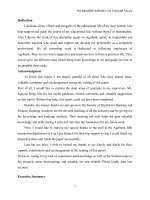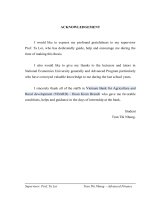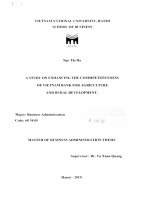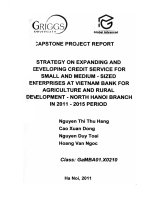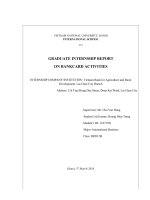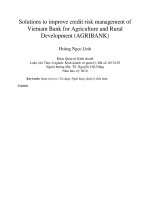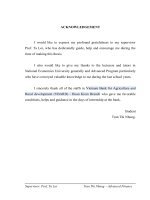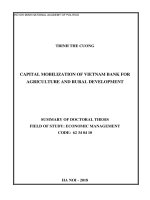Foreign exchange risk management of vietnam bank for agriculture and rural development (agribank)
Bạn đang xem bản rút gọn của tài liệu. Xem và tải ngay bản đầy đủ của tài liệu tại đây (1.06 MB, 65 trang )
VIETNAM NATIONAL UNIVERSITY, HANOI
INTERNATIONAL SCHOOL
NGUYEN THI QUYNH AN
FOREIGN EXCHANGE RISK MANAGEMENT OF
VIETNAM BANK FOR AGRICULTURE AND RURAL
DEVELOPMENT (AGRIBANK)
MASTER THESIS
HA NOI,2021
i
ABSTRACT
Thesis Title: Foreign exchange risk management of Vietnam Bank for
Agriculture and Rural Development (Agribank)
Pages: 55
University: Vietnam National University - Hanoi
Graduate School: International School
Date: January.2021
Degree: Master
Graduate Student: Nguyen Thi Quynh An
Supervisor: Dr.Mai Anh
Keywords: Bank, Exchange Rate Risk Management, Foreign Currency, Policy,
Trading
The demand for foreign currencies of corporate customers as well as the
development of foreign currency business operations of commercial banks in the
integration process is huge. Consequently, Vietnamese banks in general as well as
Vietnam Bank for Agriculture and Rural Development (Agribank) in particular
must have the right direction in the current development trend to achieve high
efficiency in business activities. The general objective of the study is to assess the
current situation of exchange rate risk management at Agribank, thereby proposing
directions and solutions to enhance exchange rate risk management at the bank in
the near future. With the suitable methods and continuous efforts in exchange risk
management at Agribank, a number of certain achievements have been obtained.
Profits from foreign exchange trading activities have continuously met the set
targets, increased and stabilized over recent years. Agribank does not face heavy
losses due to exposure to risks in general and exchange rate risks in particular. The
bank’s foreign exchange trading operations also contribute to meeting customers’
diverse foreign currency payment needs, thereby promoting the bank’s other
business activities such as national payment, foreign currency loans, guarantee, etc.
ii
to attract more customers, limit risks and increase profits for the bank. As a
reputable bank with strong brand name in the banking industry in Vietnam,
Agribank has obtained remarkable achievements. However, there are still some
shortcomings, such as the bank’s management system has not been clearly defined,
there is no specific regulation on the coordination between front office and back
office departments, there is no department to perform the function of analyzing and
managing risks in foreign exchange trading. The bank also lacks a system of
managing transaction limits and management limits for customers, banking
employees, and controllers, so the risks in foreign exchange trading are very high.
Based on those shortcoming, the author also gives some recommendations to
improve exchange rate risk management at Agribank. With the solutions given by
the research to contribute to further completing and improving the efficiency of
foreign exchange trading risk management at Agribank, the author hopes that in the
coming years, Agribank will have significant changes in foreign exchange trading
activities as well as risk management of these foreign exchange trading activities to
contribute to bringing practical benefits to the system and a small part to the growth
rate of the whole system of Agribank.
iii
ACKNOWLEDGEMENT
I would like to express my deep gratitude to my teacher, Dr Mai Duc Anh, who
enthusiastically guided and helped me throughout the process of studying,
researching and completing this research. I would like to thank the teachers and
lecturers at Vietnam National University - Hanoi, International School for their
valuable comments to help me in the process of researching and completing the
research. I would like to express my sincere thanks to the leaders and officers
working at Agribank for facilitating me to complete this research.
I hereby declare that this research is my own research work, not yet published
anywhere. All data used in this research are authentic information, subject to school
regulations and academic integrity regulations. Word count of the research is 13,968
words. I accept all responsibilities for my declaration.
iv
TABLE OF CONTENTS
ABSTRACT ............................................................................................................... i
ACKNOWLEDGEMENT ...................................... Error! Bookmark not defined.
TABLE OF CONTENTS ..........................................................................................v
LIST OF TABLES ................................................................................................ viii
SYMBOL MEANING ............................................................................................. ix
LIST OF ABBREVIATIONS...................................................................................x
CHAPTER 1: INTRODUCTION ............................................................................1
1.1 Rationale of the study ..........................................................................................1
1.2 Subject and scope of the study.............................................................................2
1.2.1 Subject of the study .........................................................................................2
1.2.2 Scope of the study ...........................................................................................2
1.3 Objectives of the study ........................................................................................2
1.3.1 General objective .............................................................................................2
1.3.2 Specific objectives ...........................................................................................2
1.4 Significant contributions of the thesis .................................................................2
1.4.1 Theoretical contributions .................................................................................2
1.4.2 Practical contributions .....................................................................................3
1.4.3 New contributions of the thesis .......................................................................3
1.5 The structure of the thesis ....................................................................................3
CHAPTER 2: THEORETICAL FRAMEWORK OF EXCHANGE RATE
RISK MANAGEMENT IN THE BANKS ..............................................................4
2.1 Foreign exchange trading by commercial banks .................................................4
2.1.1 Concept of foreign exchange trading ..............................................................4
2.1.2 Role of foreign exchange trading for commercial banks ................................4
2.1.3 Risk classification in foreign exchange trading ..............................................5
2.2 Overview of exchange rate risks of commercial banks .......................................8
2.2.1 Concepts of exchange rate risk ........................................................................8
v
2.2.2 Classification of exchange rate risks by commercial banks ............................9
2.2.3 Factors affecting exchange rate risks of commercial banks ............................9
2.3 Exchange rate risk management of commercial banks .......................................9
2.3.1 Concepts of exchange rate risk management ..................................................9
2.3.2 Role of exchange rate risk management for commercial banks .....................9
2.3.3 Content of exchange rate risk management ..................................................10
2.3.4 Exchange rate management tools ..................................................................11
2.4 Factors affecting exchange rate risk management of commercial banks ..........13
2.4.1 Objective factors............................................................................................13
2.4.2 Subjective factors ..........................................................................................15
CHAPTER 3: RESEARCH METHODOLOGY .................................................18
3.1 Data collection ...................................................................................................18
3.1.1 Secondary data ..............................................................................................18
3.1.2 Primary data collection ..................................................................................19
3.2. Data processing .................................................................................................20
CHAPTER 4: RESULTS AND DISCUSSION ....................................................21
4.1 Current situation of exchange rate risk management of Agribank in the period
of 2017 - 2019 ..........................................................................................................21
4.1.1 Process of exchange rate risk management ...................................................21
4.1.2 Details of exchange rate risk management ....................................................23
4.2 Factors affecting exchange rate risk management of Agribank ........................29
4.2.1 Objective factors............................................................................................29
4.2.2 Subjective factors ..........................................................................................30
4.3 Assessment of exchange rate risk management for the period of 2017 - 2019 of
Agribank ..................................................................................................................33
4.3.1 Achievements ................................................................................................33
4.3.2 Shortcomings and causes...............................................................................35
CHAPTER 5: CONCLUSION AND RECOMMENDATIONS .........................41
5.1 Conclusion .........................................................................................................41
vi
5.2 Recommendations to improve exchange rate risk management of Agribank ...42
5.2.1 Completing the system of departments in charge of exchange risk
management............................................................................................................42
5.2.2 Strengthening the work of building and implementing a correct and effective
customer policy ......................................................................................................43
5.2.3 Improving professional qualifications of foreign exchange trading officials
................................................................................................................................44
5.2.4 Developing the information technology system to modernize the banking
and information network ........................................................................................45
5.2.5 Enhancing banking operations related to foreign exchange trading .............46
REFERENCE LIST ................................................................................................50
APPENDIX 1: SURVEYS FOR BANKING EMPLOYEES ..............................53
APPENDIX 2: SURVEYS FOR CUSTOMERS ..................................................55
vii
LIST OF TABLES
Table 3.1. Sources of secondary data collection .......................................................18
Table 4.1. Agribank’s foreign exchange status for the period of 2017 - 2019 .........24
Table 4.2. Credit risk classification by grade and rating of Agribank ......................25
Table 4.3. Sales of spot trading foreign currencies in the period of 2017 - 2019 .....26
Table 4.4. Revenue from forward transactions in 2017 - 2019 ................................27
Table 4.5. Rate of risk provisioning ..........................................................................29
Table 4.6. Evaluation of the impact level of environmental factors .........................30
Table 4.7. Evaluation of the impact level of foreign exchange policy of the bank ..30
Table 4.8. Evaluation of the impact level of banking organization ..........................31
Table 4.9. Evaluation of the impact level of employee quality ................................32
viii
SYMBOL MEANING
<
: Smaller
>
: Bigger
$
: US Dollar
ix
LIST OF ABBREVIATIONS
Agribank
: Vietnam Bank for Agriculture and Rural Development
EUR
: Euro Dollar
FX
: Forex
GBP
: Great Britain Pound
JPY
: Japanese Yen
L/C
: Letter of Credit
USD
: United States Dollar
VaR
: Value at Risk
VND
: Vietnam Dong
WB
: World Bank
x
CHAPTER 1: INTRODUCTION
1.1 Rationale of the study
In the current economy, one of the main causes of economic crises is the
weakness of the banking system. The close relationship between banks - customers
- the economy, requires banks to be proactive in every situation; to forecast and
predict the probability of occurrence, quantify risks, thereby taking prevention
measures to minimize the impact of risks. In addition to traditional business
activities, banks are increasingly developing new business activities, including
foreign exchange trading. For banks, this banking operation serves a variety of
purposes (Tran, 2015). On the one hand, it helps meets foreign currency demand for
import and export payment, on the other hand, this is also an independent business
operation that brings a significant profit for the bank. It has the function of
providing foreign currencies in international trade transactions and also providing
exchange rate hedging tools for export earnings, import payments, investments or
loans in foreign currency. Therefore, the demand for foreign currencies of corporate
customers as well as the development of foreign currency business operations of
commercial banks in the integration process is huge. However, this is a risky
banking operation and the level of its risks is very high because it is influenced by
many factors such as economic development, exchange rates, interest rates, etc.
(Nga et al. 2013). Consequently, Vietnamese banks in general as well as Vietnam
Bank for Agriculture and Rural Development (Agribank) in particular must have the
right direction in the current development trend to achieve high efficiency in
business activities.
Therefore, the author has chosen the topic: “Foreign exchange risk
management of Vietnam Bank for Agriculture and Rural Development
(Agribank)” to make a small contribution to solving the above issues.
1
1.2 Subject and scope of the study
1.2.1 Subject of the study
The subject of the study is exchange rate risk and exchange rate risk
management by Agribank.
1.2.2 Scope of the study
Research content: The study focuses on exchange rate risk management
activities of Agribank, thereby finding the causes and solutions to improve
exchange rate risk management at the bank.
Regarding time: Research data were collected in the period of 2017 - 2019.
Regarding space: The research was conducted at Agribank - Headquarter at 2
Lang Ha, Thanh Cong, Hanoi.
1.3 Objectives of the study
1.3.1 General objective
The general objective of the study is to assess the current situation of exchange
rate risk management at Agribank, thereby proposing directions and solutions to
enhance exchange rate risk management at the bank in the near future.
1.3.2 Specific objectives
- Systematize theoretical and practical basis on exchange rate risk management
of commercial banks.
- Analyze and assess the current situation of exchange rate risk management at
Agribank.
- Propose a number of solutions and recommendations to improve exchange
rate risk management at Agribank.
1.4 Significant contributions of the thesis
1.4.1 Theoretical contributions
To synthesize and systematize the basic theory of the bank’s exchange rate risk
management, the factors affecting exchange rate risk management and summarize
lessons learned in exchange rate risk management to Agribank.
2
1.4.2 Practical contributions
- Analyze and assess the current situation of exchange rate risk management of
Agribank in the period of 2017 - 2019 to find out the limitations that need to be
overcome.
- Propose a number of suitable solutions to perfect exchange rate risk
management at Agribank.
1.4.3 New contributions of the thesis
The thesis on “Foreign exchange risk management of Vietnam Bank for
Agriculture and Rural Development (Agribank)” has shown the current situation
of exchange rate risk management of Agribank in recent years, the shortcomings
and limitations in the bank’s exchange rate risk management, from which many
solutions have been proposed to improve exchange rate risk management at the
bank, thereby contributing to developing business activities, improving both quality
and quantity in the foreign exchange trading activities of Agribank in particular and
the banking system in general.
1.5 The structure of the thesis
In addition to introduction, conclusion, tables, figures, reference list, etc., the
study has five chapters as follows:
Chapter 1: Introduction
Chapter 2: Theoretical Framework of Exchange Rate Risk Management in the
Banks
Chapter 3: Research Methodology
Chapter 4: Results and Discussion
Chapter 5: Conclusion and Recommendations
3
CHAPTER 2: THEORETICAL FRAMEWORK OF
EXCHANGE RATE RISK MANAGEMENT IN THE
BANKS
2.1 Foreign exchange trading by commercial banks
2.1.1 Concept of foreign exchange trading
According to Tin (2013), foreign exchange trading in a broad sense includes
buying, selling, borrowing and lending foreign currencies to ensure the balance of
foreign currency demand for the bank and seek to profit through exchange rate and
interest rate differences between different currencies. In a narrow sense, foreign
exchange trading is merely the foreign exchange trading activities of commercial
banks when banks participate in the domestic and foreign markets in order to ensure
the foreign currency demand of customers and earn some profit for the bank.
2.1.2 Role of foreign exchange trading for commercial banks
Foreign
exchange
trading
helps
commercial
banks
improve
their
competitiveness in the banking system, as well as their competitiveness. In any
business industry in the market, a business that wants to survive and thrive must
have products with differentiation and quality, and banks are not an exception. In
the current context, the banking industry is increasing in both quantity and quality
due to the process of liberalization, globalization and strong integration into the
financial and monetary market. In order to survive and compete strongly, banks not
only provide the products they currently have, but also have to know how to grasp
the needs of corporate customers to offer the products that they wants (Tin, 2013).
This not only increases the competitiveness of banks, but also increases the value
and diversification of their products to attract more customers to them. Thus,
foreign exchange trading has a great influence on other banking operations such as
international payment, guarantee, foreign currency loans, L/C, etc., contributing to
diversifying business activities of commercial banks.
4
Foreign exchange trading activities contribute to enhancing the position of
commercial banks in the international market through foreign exchange trading with
foreign banks, other financial and non-financial institutions. In addition, this activity
also brings a significant amount of profits to commercial banks, especially banks
whose foreign exchange trading activities develop when commercial transactions
involve the purchase and sale of foreign currencies (often with high risk level) while
the measures of hedging for exchange rate risks for import-export corporate
customers and investors are not absolutely safe. Through derivative products and
transactions in foreign exchange trading activities, banks seek profits through
interest rate difference trading channels and exchange rate speculation in the foreign
exchange market. In fact, banks hope to make a profit by taking the risk of buying a
currency today and reselling it at a later time in the future to trade for differences. If
the bank is a speculator that takes advantage of financial leverage and predicts the
future market trend, it will get a huge profit, but if the prediction is wrong, the level
of risk that the bank must bear is extremely serious. With increasingly diversified
products in foreign exchange trading activities, banks can use them as a method of
capital generation to help quickly meet the shortage of foreign currency capital
needs (Trinh, 2013).
2.1.3 Risk classification in foreign exchange trading
Foreign exchange trading is increasingly playing an important role in the
business activities of commercial banks. This is a business activity that brings a
significant source of income for the bank. The measurement and calculation to
come up with solutions to minimize risks in the banks’ business operations is very
important. Foreign exchange trading contains many risks as follows.
a. Exchange rate risk
Exchange rate is the price of one currency expressed in terms of another.
Exchange rate risk is the risk that occurs due to exchange rate fluctuations leading
to a loss in a transaction. In other words, exchange rate risk is the uncertainty of the
value of an income or payment caused by a fluctuation in exchange rates, which can
5
damage the expected value of a contract. There are two main activities that give rise
to exchange rate risk for a commercial bank, including on-balance-sheet activities
through borrowing and investing in foreign currencies, off-balance-sheet activities
through foreign exchange trading for customers and for the bank itself (Köhler,
2015). In the globalized financial - monetary - banking environment today, bank
managers are increasingly facing exchange rate risks. They make derivative
transactions rapidly develop, become diversified and complexly used in trading and
to hedge exchange rate risks.
b. Operational risks
Risks arising from the bank’s foreign exchange trading activities are the
possibilities of loss caused by non-financial factors. Operational risks include
human risk, operational risks and organizational risks.
c. Counterparty risks
According to Berger et al. (2010), counterparty risks occur when a counterpart
bank or customer does not have the ability to transact or does not want to fulfill the
financial obligations as committed in foreign exchange trading contracts and the
time of rising those commitments. In this case, real risks for the bank include costs
of canceling the contract with the current partner. To limit those risks, it is
necessary to have warnings assessing the reliability of the partners, their operations
as well as their reputation, thereby building a suitable limit for each partner,
corresponding to each type of transaction. In case they are not reputable enough and
do not have financial capacity to fulfill the committed obligations, there must be a
preventive measure to limit risks such as requiring customers to deposit, make
deposit, and apply standard reserving regulations under which partners maintains
deposit accounts in banks’ account systems, etc.
d. Liquidity risks
Liquidity risks are the inability of a bank to fail to meet its financial obligations
immediately or to raise additional capital at high costs or to sell assets at low prices.
Liquidity risks occur causing the bank to stall operations, face losses, and lose
6
credibility, and if serious, it can lead to bankruptcy. In such a case, the bank is
forced to make loans to supplement the payment capital, or sell its assets to fulfill
financial obligations such as the depositors’ need to withdraw money, etc. In the
context of increased costs for additional capital mobilization, banks were forced to
sell off immediately, even the hard-to-transfer assets at low prices because there
was not enough time to find buyers or to negotiate (Vu, 2012). Due to the urgent
sale of assets at low prices, banking solvency is threatened. In the case liquidity
risks ae more serious, bank will definitely have to face up with bankruptcy.
e. Political risks
Political risks occur when a trading partner abroad cannot fulfill the obligations
committed to in the contract of purchase and sale of foreign currencies at the time
incurring obligations commitments. The cause may be war or riot, causing
unexpected changes in financial market conditions, stock market crashes, external
risks, or macroeconomic factors such as rising inflations, fluctuations in commodity
prices, unemployment, which all affect the volatility of interest rates, exchange rates,
and liquidity (Tran et al., 2019).
In general, in foreign exchange trading, banks always face up with many types
of risks, but the most serious risk that brings the most loss to the bank is exchange
rate risk. The banking industry’s history has seen many major losses or even led to
serious collapses due to exchange rate risks in treasury departments’ operations.
The fact that the bank does not have effective risk management measures suitable to
the development of foreign exchange trading will lead to huge potential risks of
exchange rate. This means that with the unsuitable level and method of risk
management for foreign exchange trading, the bank can still operate normally and
profitably under favorable conditions. Only when the exchange rate fluctuates, then
potential risks are realized by unexpected huge losses. Therefore, the management
of exchange rate risks is very important in order to help banks prepare for adverse
changes in exchange rates in foreign exchange trading activities, to avoid
unexpected damages and losses in foreign exchange trading for banks when the
7
exchange rate fluctuates unexpectedly, and ensures high profitability for banks with
the lowest level of risk, reducing sensitivity to changes in the exchange rate
environment, enhancing competitive advantages for banks.
2.2 Overview of exchange rate risks of commercial banks
A commercial bank is characterized by a financial intermediary, so its basic and
thorough operation is to transfer capital (domestic currency, foreign currency) from
people with surplus capital to under-capitalized people, creating efficiency in using
higher capital, increasing socio-economic efficiency. The Bank uses its professional
skills to establish a portfolio of services to the society such as: mobilization, lending,
domestic guarantee, international guarantee, domestic payment, international
payment , consulting ... In addition, banks must also maximize profits by
diversifying investment portfolios: investing in bonds, stocks, foreign currencies ...
It can be said that banking activities face many the most risky. In addition to the
normal risks faced by other activities such as interest rate risk, credit risk, liquidity
risk, technical risk, operational risk, legal risk, reputation risk, and strategic risk…
the banking operations also incur an additional special risk, which is the exchange
rate risk. Due to frequent fluctuations of exchange rates, exchange rate risk is
considered a permanent risk associated with banking operations.
2.2.1 Concepts of exchange rate risk
Risk is the possibility of an instability or uncertainty that can predict the
probability. Exchange rate risk is the type of risk that is caused by exchange rate
fluctuations affecting the expected value in the future. Exchange rate risk may arise
in many different activities of the bank as well as of customers (Lepetit et al., 2008).
However, not whenever the exchange rate fluctuates, commercial banks will
face exchange rate risk. The volatility of the exchange rate is only a necessary
condition to expose the bank to exchange rate risk because if the commercial bank's
business only involves domestic currency and takes place domestically, the
exchange rate risk is now zero. In fact, commercial banks do business in the
monetary sector including domestic and foreign currencies, so the next section will
8
study the eligibility or the main reasons for a bank. Commercial goods are exposed
to exchange rate risk when conducting business transactions.
2.2.2 Classification of exchange rate risks by commercial banks
Exchange rate risks of commercial banks include foreign exchange risks and
swap rate risks, status risks, risks in the implementation of the transactions, risks of
payment and credit, sovereign risks, etc. (Lepetit et al., 2008)
2.2.3 Factors affecting exchange rate risks of commercial banks
According to Poghosyan and Cihak (2011), the subjective cause is due to
disproportionate foreign exchange status, that is, there is a difference in the value of
assets and liabilities or a difference between the revenue from buying and from
selling of a foreign currency. The objective cause is due to the exchange rate
fluctuation in an unfavorable direction for banks. The causes of this fluctuation are
the supply and demand of foreign currencies in the market, the difference in interest
rates and inflation among countries, in addition there are other factors such as
government policies, expectations and sentiment.
2.3 Exchange rate risk management of commercial banks
2.3.1 Concepts of exchange rate risk management
Exchange rate risk management is a scientific, comprehensive and systematic
process of approaching exchange rate risks to identify, measure, control and
minimize the adverse effects of exchange rate risks. The ultimate purpose of
exchange rate risk management is to ensure that risks are controlled within banks’
ability, while maximizing the value the bank expects to achieve under variable
conditions of the business environment (Lepetit et al., 2008).
2.3.2 Role of exchange rate risk management for commercial banks
Well-implemented exchange rate risk management will contribute to improving
the quality and efficiency of commercial banks’ business operations. Good
exchange rate risk management contributes to reducing risks in foreign exchange
trading. Good exchange rate risk management also contributes to enhancing the
competitiveness and international integration of commercial banks.
9
2.3.3 Content of exchange rate risk management
The issue of managing foreign exchange risk is of great concern to everyone
participating in the foreign exchange market. Risk management includes risk
analysis and control. In which risk analysis plays an important role, by using
statistical economic tools to analyze prediction, systematically quantify the level of
risk associated with the forecast capital project, from which the cost compensation
can be calculated to have the basis for the best decision. Risk control is based on
analysis results providing instrumental measures to limit and offset risks.
a. Risk identification
This is considered as the first step in the process of managing exchange rate
risks at the bank. Exchange rate risk is a form of market risk, so the losses brought
by the market can be determined. Exchange rate risk occurs when there is an
exchange rate movement of foreign currencies held by commercial banks as assets,
liabilities or both. Banks participate in the foreign exchange market with two main
purposes: customer service (buying and selling on behalf of customers) and trading
for themselves (self-employment). Exchange rate risk only arises when the bank is
proprietary, i.e. create an open position for investment to earn profits when the
exchange rate changes. In foreign exchange trading, exchange rate risks bring losses
to a bank when there is an open foreign currency position (Nguyen, 2019). Thus,
any foreign exchange trading activities that create an open foreign currency position
are exposed to the risks caused by exchange rate fluctuations.
b. Risk measurement
The commonly known method of measuring exchange rate risks is Value at
Risk (VaR). VaR is the bank’s expected loss on exchange rate fluctuations. The
limit of risk value is the maximum expected loss that the bank can withstand.
Value at risk = Foreign exchange position - Estimated volatility of exchange
rate - Closing rate
c. Risk control
10
Risk control is the implementation of measures to minimize risks before risks
occur such as: avoiding, preventing, minimizing, neutralizing risks, etc. Specific
measures that banks take include limit on foreign exchange positions (this can be
seen as a measure of risk avoidance and risk prevention because, in principle, if
customers need to transact beyond the limit, the bank will refuse), balancing net
foreign currency position regarding term and size, use of derivative tools, and
diversification of currencies (Brown, 2001).
d. Risk financing
Risk financing is the implementation of financial measures to minimize the
adverse effects of a risk when this occurs, for example: self-remedy by contingency,
with available resources, or transfer of risk through insurance contracts, etc. In
addition to a number of methods to limit risks, banks need to deduct a portion of
their profits to be used as a risk financing fund for foreign exchange trading. Just
like credit activities, every year, a part of profit must be deducted to compensate
and prevent bad debts. In foreign exchange trading, risks always occurs
concurrently with open trading, which means that the foreign currency position does
not need to be equal. Setting up risk financing fund can be 10% -20% profit of that
year on foreign exchange trading (Honohan, 2007).
2.3.4 Exchange rate management tools
a. Forward
A forward transaction is a transaction in which two parties commit to buy and
sell together an amount of foreign currency at a certain exchange rate and the
payment will be made at a specified time in the future. Forward contract is the
oldest instrument, and because of that, it is very complex. A forward contract is an
agreement between two parties to buy or sell a certain amount of foreign currency,
at a fixed exchange rate and at a specified time in the future. It can be understood
that a forward contract is an agreement between the buyer and the seller at this point
that the buyer will pay the seller at the agreed term price and the seller will deliver
the goods to the buyer at the time the contract expires. Forward contract rate is
11
determined at the time of signing the contract but applies to a specified time in the
future (Honohan, 2007).
b. Future
Futures transaction is a transaction standardized in the type of foreign currency
traded, transaction turnover and transaction date. Future transaction is done
centrally through an exchange broker. A future contract is an agreement to buy or
sell a fixed amount of foreign currency in the future at a fixed exchange rate on the
contract date (Mishkin, 2004).
The trading mechanism of futures contract is that all futures contracts trade at
the Exchange and the Exchange controls the activities of members. Members of the
Exchange are individuals, which can be representatives of companies, commercial
banks or individuals with separate accounts. Individuals, companies, and banks send
orders to buy or sell a specified amount of foreign currency to brokers or members
of the Exchange. At the Exchange, buy orders, also known as in long position, are
compared with sell orders, also known as in short position. A clearing company at
the Exchange guarantees both buying and selling sides that orders after being
confirmed to match with each other will surely be executed.
Clearly, if using future contracts as a hedge against exchange rate risks, they
still contain potential exchange rate risks; while forward contracts completely
eliminate those risks. Future contracts are always the speculators’ choice as a hedge
against exchange rate hedging because the gains arising from futures contracts are
received in cash and on the same day, transaction costs are very low, the Exchange
can set a limit on the future price by specifying how much the settlement price of
today is increased or decreased from the previous day’s settlement. That is, the daily
rate fluctuation can be limited by the Exchange (Allayannis et al., 2001).
c. Swap
Swap transaction is a double exchange transaction consisting of two operations:
spot exchange and forward exchange, these two transactions are carried out at the
same time, with the same amount of foreign currency or gold in two opposite
12
directions. A swap is the simultaneous buying and selling of a certain currency,
where the buying value date and the selling value date are different. Like a forward
contract or a spot contract, a swap contract also has a buy and sell contract. Suppose
a contract to buy and sell a currency is signed simultaneously at the same time today,
if there is no other agreement, buying a currency means that the bank buys the base
currency, and selling a currency means that the bank sells the base currency
(Matousek et al., 2017).
d. Option
Option transaction is a transaction between the buyer and the seller, in which
the buyer has the right but not the obligation to buy or sell a specified amount of
foreign currency at a specified exchange rate/price for a period of time/prior
agreement. A currency option contract is a financial instrument that gives the
contract buyer the right (but not the obligation) to buy or sell one currency for
another at a pre-agreed fixed rate and at a certain time in the future.
There are certain risks to options trading. The option buyer is exposed to the
risk of losing all or part of the cost paid to buy the option. If the holder does not
resell his option on the secondary market and does not exercise it before it is due, he
loses the full amount of the premium. For the seller of the option, the seller is
obliged to perform the contract at any time during the contract term requested by
the buyer, and at the same time they risk losing their profit opportunities when the
exchange rate is delivered right at the time the contract expires, higher than the rate
for the option (Dinh & Kleimeier, 2007).
2.4 Factors affecting exchange rate risk management of commercial
banks
2.4.1 Objective factors
a. Legal basis
Legal basis is a decisive condition to the effectiveness of exchange rate risk
management in the bank’s foreign exchange trading activities. With legal
documents such as laws, ordinances, decisions, etc., the State creates a legal
13
condition for foreign exchange trading, as well as exchange rate hedging operations,
but not ever. These policies are also consistent with the laws of the market. When
that polices are not appropriate, they will limit the effectiveness of exchange rate
risk management. For example, the State Bank sets the forward exchange rate equal
to the spot rate plus a percentage of the spot rate, regardless of the interest rate of
two exchange currencies. Therefore, when the exchange rate increases sharply,
banks do not dare to take risks to offer forward or option contracts (Dufhues, 2003).
Every year, the State promulgates many new policies to supplement and change
the old legal provisions that are no longer suitable for the market conditions in the
new period. Foreign exchange trading transactions are not only done for a few days
but many transactions in several years, or transacted not only domestically but also
with other countries, for example, the transactions of mobilizing and lending in gold.
Once the government policy changes and the bank does not fully anticipate it, it will
create many difficulties for the process of managing risks in banking business. The
State’s policy changes bring policy risks to banks. As recently, the State Bank has
issued a policy to settle gold deposits and loans, which has brought losses to
commercial banks.
In general, in order to create conditions for banks to apply foreign exchange
trading operations and to hedge exchange rate risks effectively, it is necessary to
have favorable conditions suitable to the level of market development and the level
of development of each bank.
b. Market conditions
Foreign exchange trading activities are always in a volatile environment both at
home and abroad, although banks have many preparations in their business plans,
they cannot anticipate all the difficulties the market will bring. For that reason, the
bank’s business activities are always potentially risky and changes in the external
business environment often cause many difficulties for the bank’s business risk
management (Kousted et al., 2005).
14
A bank can only apply exchange rate hedging instruments when the foreign
exchange market has developed to a certain extent. If the market develops with a
full range of institutions and financial instruments to operate foreign exchange
transactions, capable of meeting all transactions of foreign currency derivative
transactions, then the bank’s management of exchange rate risks will get better
results. At that time, the bank will have more complete information to help forecast
exchange rate fluctuations more accurately and easily in assessing the market. On
the contrary, if the foreign exchange market is underdeveloped, the implementation
of foreign exchange trading operations and risk prevention is very limited, and
banks will also find it difficult to manage their exchange rate risks.
c. Customers
Customers’ business capacity is weak. They are not good at making business
plans, budget planning, estimating all expenditures, which results in incorrect
determination of income for bank debt repayment. The use of capital is not effective
and for wrong purposes, the purpose of applying for loans and business efficiency
has not been brought into full play, so when due, it is impossible for corporate
customers to pay debts to the bank, or they lose their liquidity (Nguyen & Stewart,
2013).
2.4.2 Subjective factors
a. Badly compliance with banking risk management policies and procedures
Although the bank has in place a risk management system for business
operations, improper compliance with the regulatory system creates many risks for
the bank’s overall operations. Failure to comply with the provisions of this policy
may arise from the side of the leaders who do not manage risks according to the
regulations or may arise from the side of the implementers who are not follow
strictly the regulations or intentionally violate the regulations for a certain reason.
The improper implementation of the regulations in the risk management system in
business operations can bring a lot of damage to the bank and make it more difficult
15

